Introducing the world of Audi Q5 ownership, where style meets unmatched driving ability. The Audi Q5 is popular among SUV fans who want a high-end driving experience. It is known for its luxury, technology, and engineering ability. However, like any other high-tech machine, the Audi Q5 has some problems that owners may encounter.
Today, we will discuss a widespread problem that some Audi Q5 owners have had: the fuel pump flange leak. This problem is well-known in the Q5 community, so Audi started a recall effort to fix the possible performance and safety risks. We aim to highlight this important subject and give you the knowledge to find, understand, and fix the problem so your car stays in great shape.
Whether you’re an experienced Audi fan or a new Q5 user just starting to learn more about it, this guide should give you the information you need to ensure your Audi keeps giving you the great performance you’ve come to expect. Bear with us as we figure out how to fix the fuel pump flange issues so your Audi Q5 stays the best car ever.

OEM fuel pump flange by VDO
Understanding the Fuel Pump Flange
The fuel pump flange is at the core of your Audi Q5’s powerful fuel system. This important part might not get much attention, but it is crucial to ensure your car runs smoothly and reliably. The fuel pump flange protects the fuel tank and houses the fuel filter, keeping these important parts safe from outside damage and contaminants. The location and purpose of this part are very important for keeping the fuel that runs your engine clean.
But problems can happen with even the best-designed systems, and the fuel pump flange is no different. There are some clear signs that this part might be leaking that can help you find it. The smell of fuel, especially on the right side of your car, might be the most obvious sign of a problem with the flange’s integrity. On top of that, you might see leaks under your car, which is something no car owner likes to see. Another less obvious sign could be a slow but steady drop in fuel economy, which means that not all the fuel your Q5 uses is for moving.
Interestingly, this problem doesn’t just happen with the Audi Q5. The Porsche Macan, which is its brother, has a similar structure and, as a result, the same fuel pump flange weakness. This problem is the same across gasoline engine models, which shows how important it is to fix it immediately, whether you’re driving an Audi Q5 or a Porsche Macan.
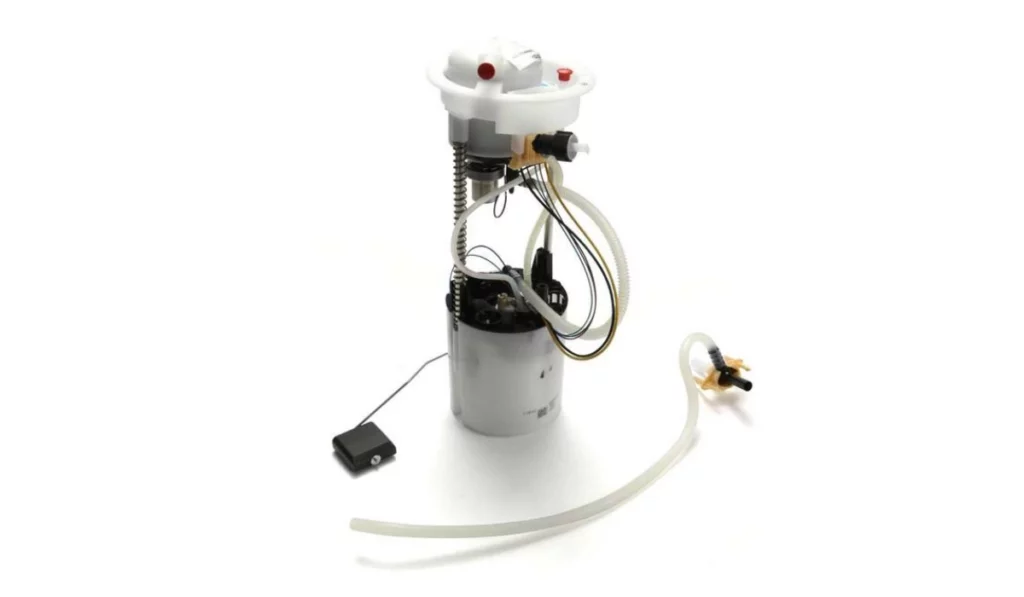
Genuine VW/Audi fuel pump unit
By being alert and noticing these early warning signs, you can stop the problem before it worsens. This will keep your ride safe, smooth, and enjoyable. Continue reading to learn more about what a leaking fuel pump flange means and what you must do next to keep your Audi Q5 working well.
Secure Fantastic Deals on Authentic Audi Parts
Step into the world of eEuroparts.com for a comprehensive array of genuine Audi and OEM parts, all at prices that defy the online market. Our mission is to serve every Audi enthusiast with elite automotive parts, making the high cost of maintenance obsolete. Our wide-ranging catalog is meticulously put together to match your Audi’s particular needs, ensuring a perfect fit and strict conformance to OEM standards.
By choosing eEuroparts.com, you’ll save significantly without sacrificing the integrity of your parts. This makes us the favored destination for Audi DIY enthusiasts who prioritize unparalleled value and unwavering quality.
How the Leak Affects Your Audi Q5
If you don’t fix your Audi Q5’s leaked fuel pump flange, it could cause a chain of problems much worse than an annoyance. This problem could seriously affect not only the vehicle’s performance but also your safety.
Risks of Fire and Safety
The most scary thing that could happen if the fuel pump flange leaks is that there is a greater chance of a fire. Fuel is naturally very flammable, and a leak in the fuel system can make it easy for something to catch fire.
This risk increases greatly if the leaking fuel comes into contact with hot engine parts or an electrical spark. A smell of fuel, especially inside the car or on the right side, is a very important sign that must be taken care of immediately. Ignoring this warning could have terrible results, like the car catching fire.
Reduced Performance
How your Audi Q5 runs depends on all its fuel system parts working together properly. A leak in the fuel pump flange prevents the fuel system from generating enough pressure, which means the engine doesn’t get enough fuel pressure and flow. This can show up as a noticeable drop in acceleration, power, and general driving dynamics, detracting from the classic Audi driving experience.
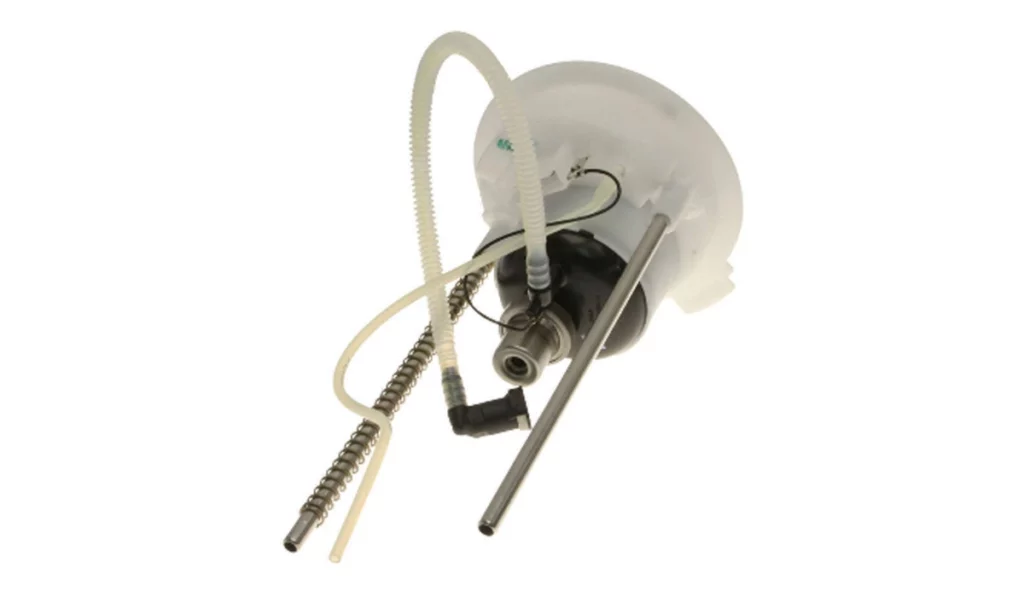
Genuine VW/Audi fuel pump flange
MPG went down
A damaged fuel pump flange can also affect your Audi Q5’s fuel efficiency. If the system leaks, a lot of fuel could be wasted, and some might never get to the combustion chamber. This wasteful behavior often shows up as a drop in miles per gallon (MPG), which means more frequent and more expensive trips to the gas station.
Repair costs have gone up
A leak that seems small initially can quickly become a bigger problem if not fixed immediately. Constant fuel loss costs money and can put extra stress on other parts of the fuel system. Over time, this can cause more damage, needing bigger and more expensive fixes.
When it comes to a fuel pump flange leaking, the saying “a stitch in time saves nine” is especially true. Moving quickly if you smell fuel or see any other signs of a leak is very important. If you put off repairs, what could have been an easy fix can become complicated and expensive.
Remember that you and your passenger’s safety are the most important thing. As soon as you notice a problem with your Audi Q5, you should get to work to figure out what’s wrong and fix it. This will keep your car safe and reliable on the road.
Identifying the Fuel Leak on the Audi Q5’s Fuel Pump Flange
It’s important to find a fuel leak in your Audi Q5 as soon as possible, especially one coming from the fuel pump flange, to keep your car safe and running well. Here are some ways to look for possible leaks:
Fuel Smell
The smell of fuel, especially on the right side of your car, is one of the most obvious signs that your fuel pump flange is leaking. Pay close attention to the area around the rear right seat. If you smell gasoline that doesn’t seem to come from anywhere, it’s likely that there is a leak in the area around the fuel pump flange.
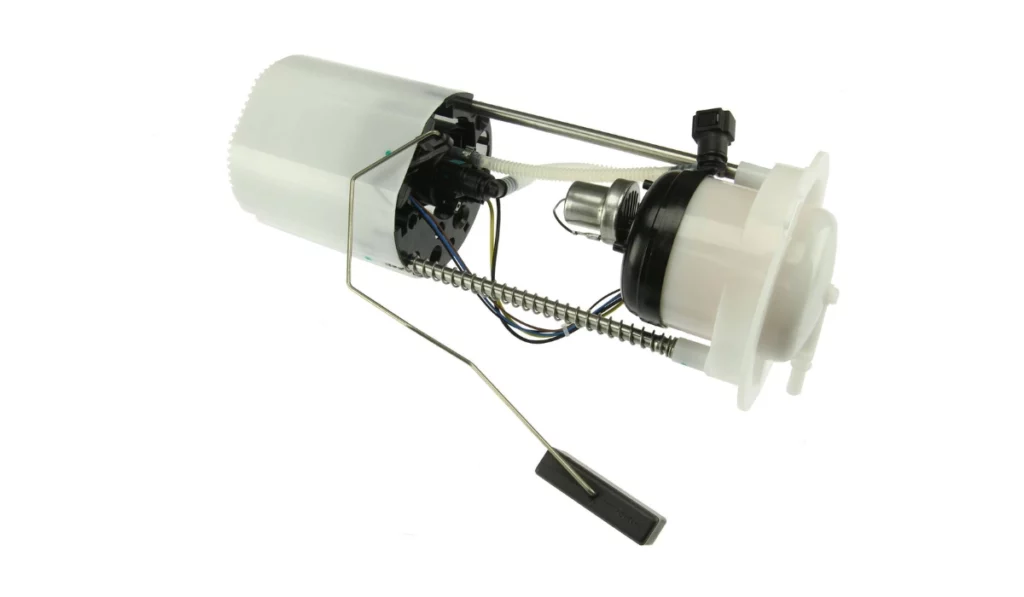
OEM fuel pump unit by URO
Visual Inspection Underneath the Car
You should occasionally check the bottom of your Audi Q5, especially around the back seats. If you can see fuel leaking or stains on the bottom of your car, it could mean that the fuel pump flange is cracked and leaking. Not only are these leaks dangerous because they can start fires, but they can also pollute the environment and waste fuel.
Monitoring Vehicle Performance
If your Audi Q5’s fuel pump flange leaks, it can directly affect its performance. One symptom is an engine that stops running or loses power suddenly, especially when speeding up. Often, these acceleration issues are caused by the engine not getting enough fuel, which is caused by a leak in the fuel system.
You can catch a possible fuel pump flange problem before it gets worse by looking for these signs: the smell of fuel, obvious leaks, and erratic vehicle performance. If you catch problems and fix them immediately, you can avoid bigger, more expensive repairs down the road and keep your Audi Q5 running safely and efficiently.
Fixing a Leaky Fuel Flange on the Audi Q5
Addressing a leaky fuel pump flange in your Audi Q5 requires careful attention to detail and adherence to safety protocols. Before we discuss the tools you’ll need and the step-by-step guide for replacement, let’s outline some critical safety instructions to remember when working on the fuel system.
Safety Instructions
Ventilation is King
Before you pop the hood and get down to business, make sure your garage or workspace has ample airflow. Fuel fumes aren’t just unpleasant; they’re downright dangerous if they build up. Crack open those doors and windows, or better yet, work outside if you can.
Banish Flames and Sparks
This one’s non-negotiable. Any ignition source, from cigarettes to that old work light you’ve meant to replace, must stay away from your work zone. Remember, turning a routine repair into an emergency only takes one spark.
Gear Up
Don’t skimp on the PPE (Personal Protective Equipment). A solid pair of working gloves will keep the fuel off your skin, and safety goggles are a must to protect your eyes from splashes. This isn’t just about comfort; it’s about preventing harm.
Pressure’s Off
Before you loosen a bolt so much, ensure the fuel system’s pressure is dialed to zero. This might mean running the engine after pulling the fuel pump fuse or relay. The fuel pump fuse is located on the left side of the dashboard, positioned at B3 — 25A. Cross-check with your owner’s manual to confirm. The last thing you need is gasoline making an unexpected entrance.
Disconnect the Battery
First thing’s first: Pop open that trunk and disconnect the battery’s negative terminal. It’s not just about preventing electrical shorts; it’s about ensuring the entire electrical system is off while you’re working. It’s a simple step, but it’s your first line of defense against unexpected electrical activity.
Have a Fire Extinguisher Handy
No matter how careful you are, the fire risk is never zero when dealing with fuel. Keep a fire extinguisher within arm’s reach — not just any extinguisher, but one rated for chemical fires (Class B, preferably ABC). It’s not just a box to tick for safety regulations; it could be a lifeline in an emergency.
Tools Required
Having the right tools at your disposal is crucial for efficiently replacing a leaky fuel pump flange. Ensuring you have a comprehensive toolkit will facilitate a smoother repair process and help avoid unnecessary complications. Here are some of the tools you’ll need:
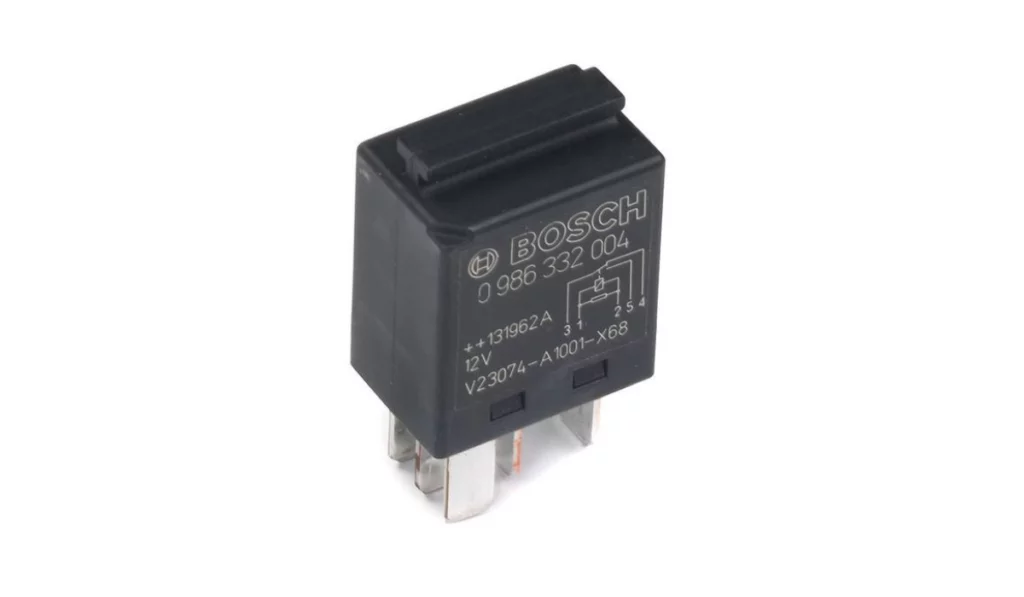
- Safety goggles
- Working gloves
- Shop towels or rags
- OBD-II scanner
- Ratchet and socket set
- M10 triple square bit
- Screwdriver set
- Fuel pump flange nut remover (T10202)
- Brass punch
- Vacuum cleaner
- Oil drain pan
Step-by-Step Replacement Guide
The replacement process involves several key steps. While the detailed steps will be provided for you to follow, the general process includes removing the rear seat, disconnecting the battery, getting access to the fuel pump flange, and carefully removing and installing the new fuel pump unit with precision to ensure a secure, leak-free fit. Here are the steps to follow.
Removing the Rear Right Seat
Remove the ISOFIX covers on the rear right seat, then pull the rear right seat upward at its front section. Remove the seat cushion and place it in storage. Afterward, use an m10 triple square bit and a ratchet to lose all four screws holding the seat. Once all four are removed, fold the seat and move it to the side.
Accessing the Fuel Pump Flange
Use a positive screwdriver to undo the three screws for the fuel pump flange cover. With that, the fuel pump flange is now in your view. If it is flooded with fuel or soiled with dust and debris, clean it up using rags and a vacuum cleaner. Remember, cleanliness is very important, especially while working on the fuel system
Removing the Fuel Pump Unit
Remove the electrical and fuel connections now that the fuel pump flange is clean. Prepare a rag or shop towel when removing the fuel connection, as fuel may still come from it. Then, set the connections aside.
Use the fuel pump flange nut remover (T10202) to remove the nut holding the fuel pump flange. If you don’t have this tool, a brass punch will do just fine. Mark its initial position first to ensure it is fitted correctly later.
Lift up the fuel pump flange to remove the fuel pump unit from the fuel tank. You may also need to disconnect electrical connections and pipes when removing it. It may require patience and perseverance as you maneuver the fuel pump unit to remove it, so just hang on.
The fuel pump unit may still have some gasoline on it. Use a shop towel, rags, and a drain pan to prevent the gas from spilling everywhere. Do not attempt to fill the gasoline back into the tank, as this fuel might be contaminated with fine particles from the fuel filter.
Installing the Fuel Pump Unit
Set the drained fuel pump unit on a bench and compare it to the new one. Depending on your new fuel pump unit, you might need to transfer a suction jet pipe from the old one to the new one.
The rest of the installation process is just the reverse of the removal. Below are some important tips to ensure that the DIY repair you have just done is done correctly and safely.
- Remember to reinstall the fuel pump fuse you removed to relieve the fuel pressure. Your engine won’t start if you forget this step.
- Always replace the fuel flange seal. It cost peanuts.
- Tighten the fuel pump flange nut using the flange nut remover (T10202) to 74 ft. lb (100 Nm). If you used a brass punch. Aim to line up your markings before the removal.
- Recalibrate the fuel level sensor with an OBD-II scanner to ensure accurate fuel level measurement.
- Install the seat as the last part of the step. This is done so you can view your work if there is any leak or something went wrong.
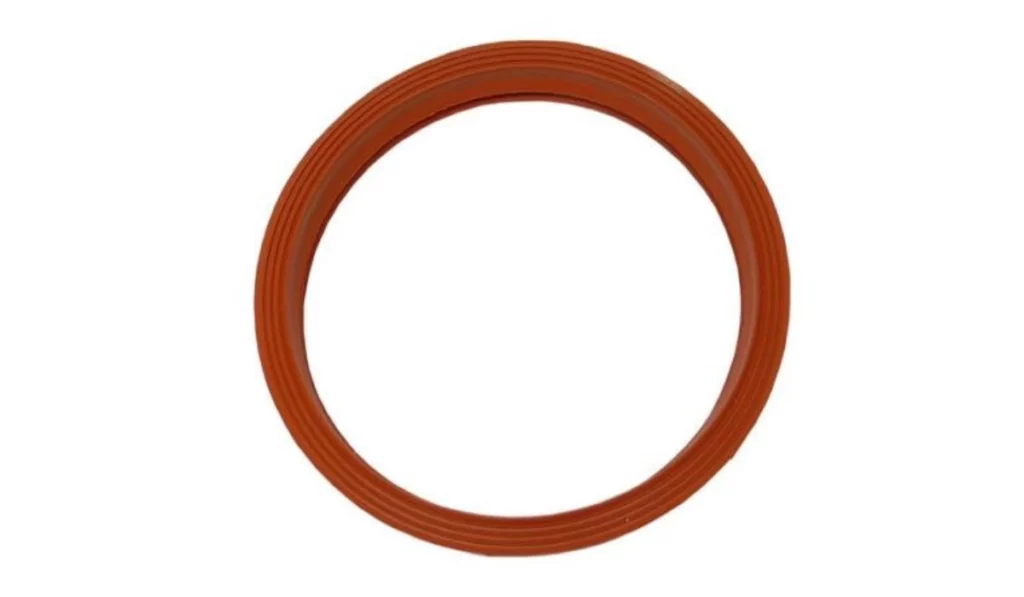
Preventive Measures and Regular Maintenance
You can keep your Audi Q5 working smoothly by doing more than just fixing problems as they come up. You should also take steps to ensure they don’t happen in the first place. Here’s how to keep your fuel system in great shape, including that important fuel pump flange:
Make Sure You Use Premium Fuel
It may be tempting to save a few pennies at the petrol station, but premium fuel is best for your Audi Q5. Poor quality fuels can add impurities to your system, which can cause filters to get stuck and performance to drop. Think of it as an investment in your car’s long-term health and performance.
Be Alert for Fuel Smells
A whiff of gasoline isn’t something to brush off. We need you to act immediately if you smell that, especially near the back right seat or under the car. Fuel leaks can get worse very quickly, which is very dangerous. If you find and fix problems early on, they might not get worse later on.
Regular Replacement of the Fuel Filter
Audi doesn’t say how often the fuel filter on a gasoline engine needs to be replaced, but a little preventative care can go a long way. If you live in an area with bad fuel quality, changing the fuel filter every 70,000 to 100,000 miles may help keep the fuel system clean and working well. This is especially important in places where the fuel quality isn’t as good because contaminants can damage filters more quickly there.
By following these preventative steps and doing regular maintenance on your Audi Q5, you’re not only making sure it runs at its best, but you’re also protecting yourself from problems that could happen in the future. To keep your Audi Q5’s fuel system healthy and running well, you need to keep a close eye on the quality of the fuel, be on the lookout for leaks, and change the filters on a regular basis.
Choose eEuroparts.com for your Next DIY Challenge
For Audi Q5 owners facing a leaking fuel pump flange issue or any other repair, eEuroparts.com is your trusted partner. Our expansive inventory is tailored for Audi Q5, ensuring you find high-quality parts for a successful DIY project.
Beyond just parts, eEuroparts.com offers expert advice to guide you through your repair journey, coupled with competitive pricing and fast shipping to get you back on the road quickly. Our commitment to customer satisfaction is unwavering, with a dedicated support team and a hassle-free return policy to ensure a seamless experience.
Choose eEuroparts.com for quality, reliability, and comprehensive support for all your Audi Q5 maintenance needs. Shop with us today and embrace the confidence to tackle your DIY challenges head-on.










